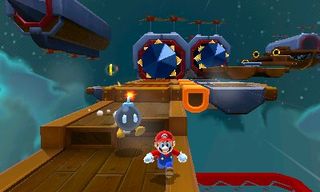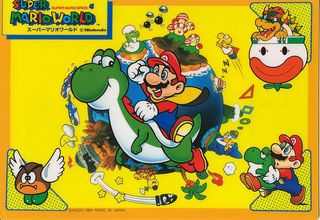GR: Were changes like that, and taking out Mario’s ability to punch and kick from previous 3D titles, tough for the dev team to deal with at first?

KH: As I was saying earlier, we always have to look for expressions that match the world that we’re creating. In the case of previous 3D Mario games, we would have two objects on a flat plane, and the kind of action Mario would do might be based on the proximity of those two objects. Your distance from the enemy when you initiate an action could result in a spin or punch or kick, depending on far you are from this other object on a flat plane.
But in the case of 3D Land, we had the stereoscopic display, which allowed people to judge depth perception in an entirely different way. We wanted to use this as an opportunity to get people back into the habit of thinking of stomping on enemies as the main action that Mario undertakes. In a 3D world that had always been a challenge for some people. And we think we succeeded in fixing that. For those that still found the idea of stomping an enemy even with the 3D display somewhat challenging, they have the Tanooki Suit’s tail, which is a really good match. It reminds people of the spin attack from Galaxy, but uses something unique about the suit.
GR: Galaxy 2 began development with ideas that couldn’t fit in Galaxy 1. After finishing the second game, were you left with any ideas that could appear in a possible third game?
KH: When we worked on Galaxy 1 we came up with a mountain of ideas. Of course, the ideas that made it in to the final product were the ones at the very top. Those ideas that were most compelling or could be implemented most easily and effectively. The other ideas were a little bit rougher. Ideas we weren’t positive that’d be as effective, or might have been much more difficult to include.
When you think about trying to make a game like Galaxy 2 from that large group of ideas that we had already decided were on the rough side, that becomes a very difficult project. The only way that we got through the development of Mario Galaxy 2 was by coming up with entirely new ideas. I think of that as a very challenging project when I look back on it.
From that perspective, to say we’d make another game using the ideas left over from Galaxy 2, it’s very difficult for me to imagine. I feel like we really did research the field very well for possible ideas and we used everything that was reasonably easy to implement.
GR: I’m sure it’s a very long time from now, but do you think that you and other high level Nintendo developers are prepared for Miyamoto’s eventual retirement?
KH: Of course Mr Miyamoto is not going to retire any time soon, and I have to say I’m going to be working hard as I can on games now and in the future. But Nintendo is made up of a lot of really great ideas, many of which were contributed by Mr Miyamoto himself. We all care very much about these ideas, we try hard to grasp them and use them in our work. We also do our best to pass along these ideas to the next generation of developers, and that’s an ongoing process.
GR: Within Mario fandom, there’s often an argument about which is the best 2D Mario game: Super Mario 3 or Super Mario World. Simply as a fan, where do you fall?

KH: Well, this is just my personal preference, but I would have to say that I am really into Super Mario World. The reason for that is it was the first Mario game that I was able to beat. I had Mario 3, but I think I only got as far as World 4 or so. (Beating Mario World) was a really good memory for me, and I wanted to carry that forward into the development of 3D Land, which is why I tried to design the game so that a lot of people would be able to clear the game at least through the normal ending. They could then have that good feeling of seeing the ending of a game.
GR: Interesting. Well, our time is up. Thanks so much.

